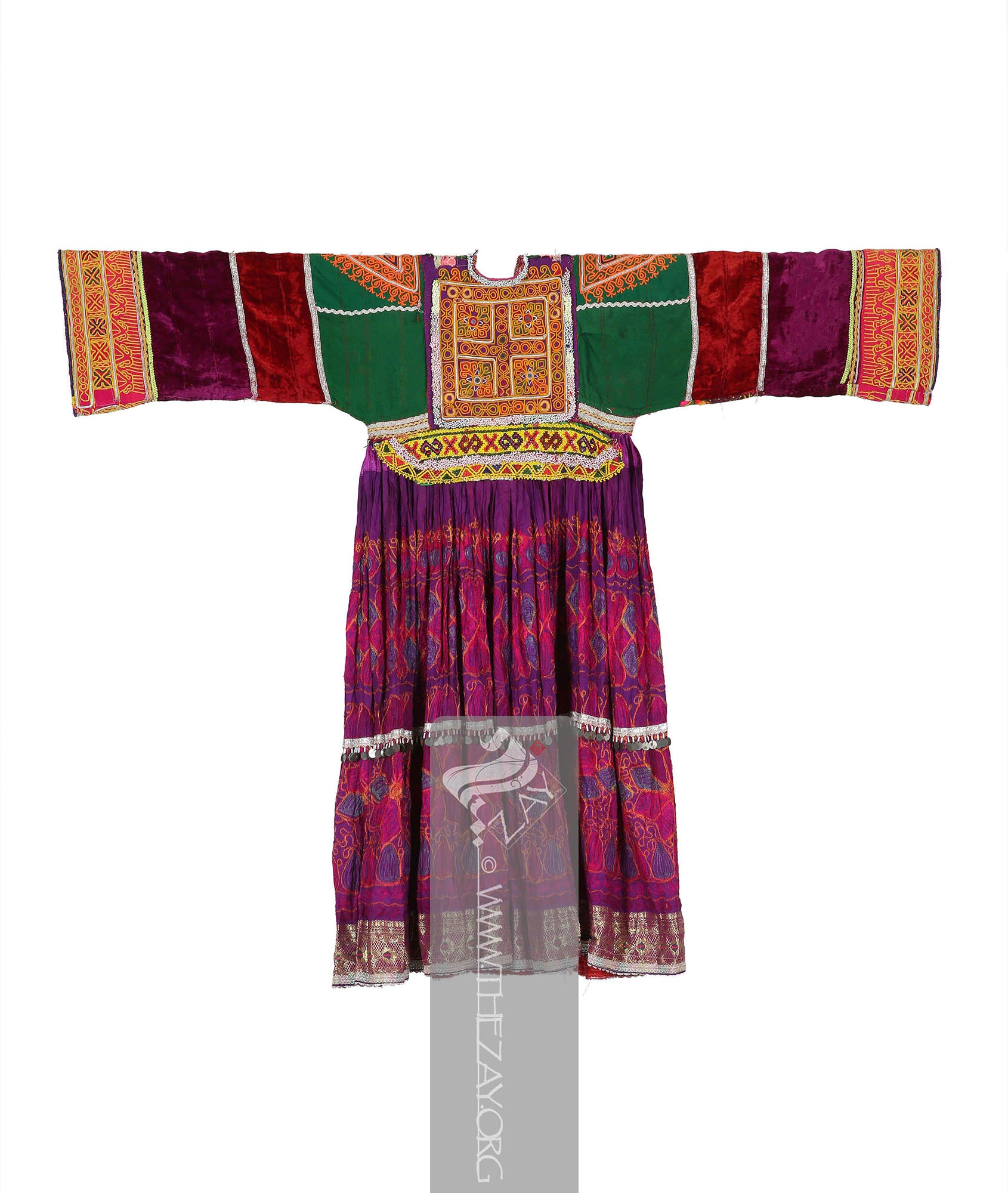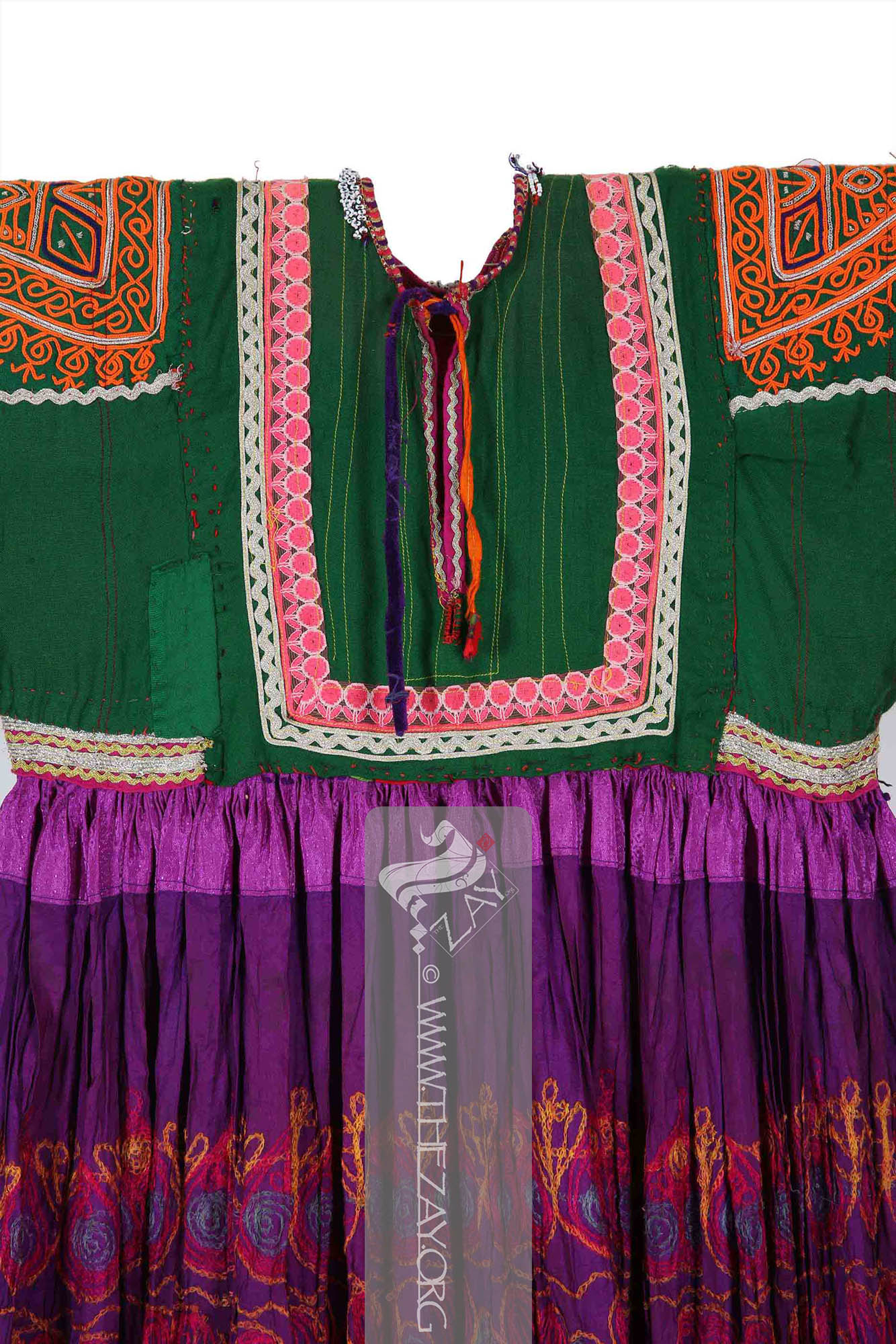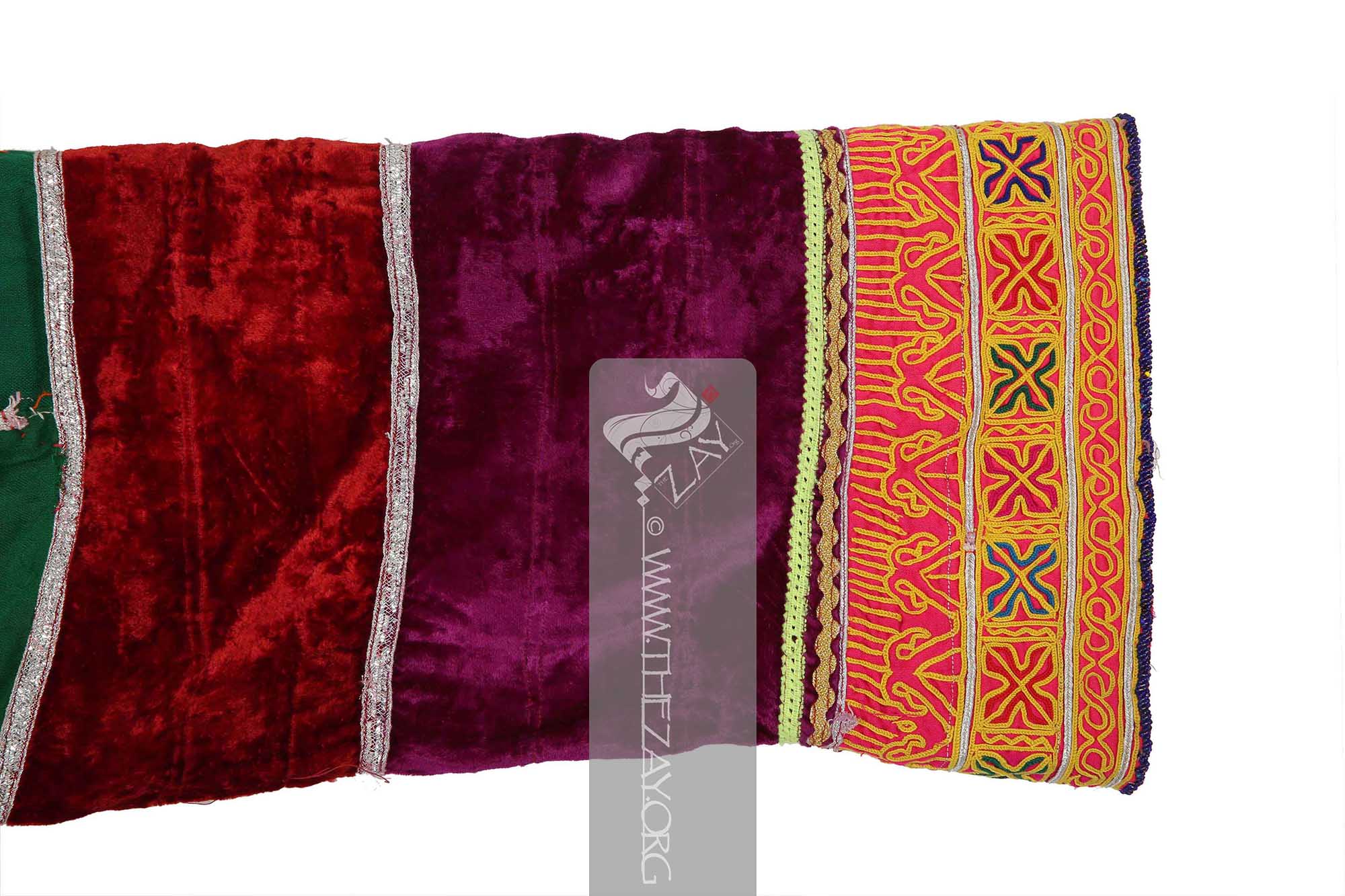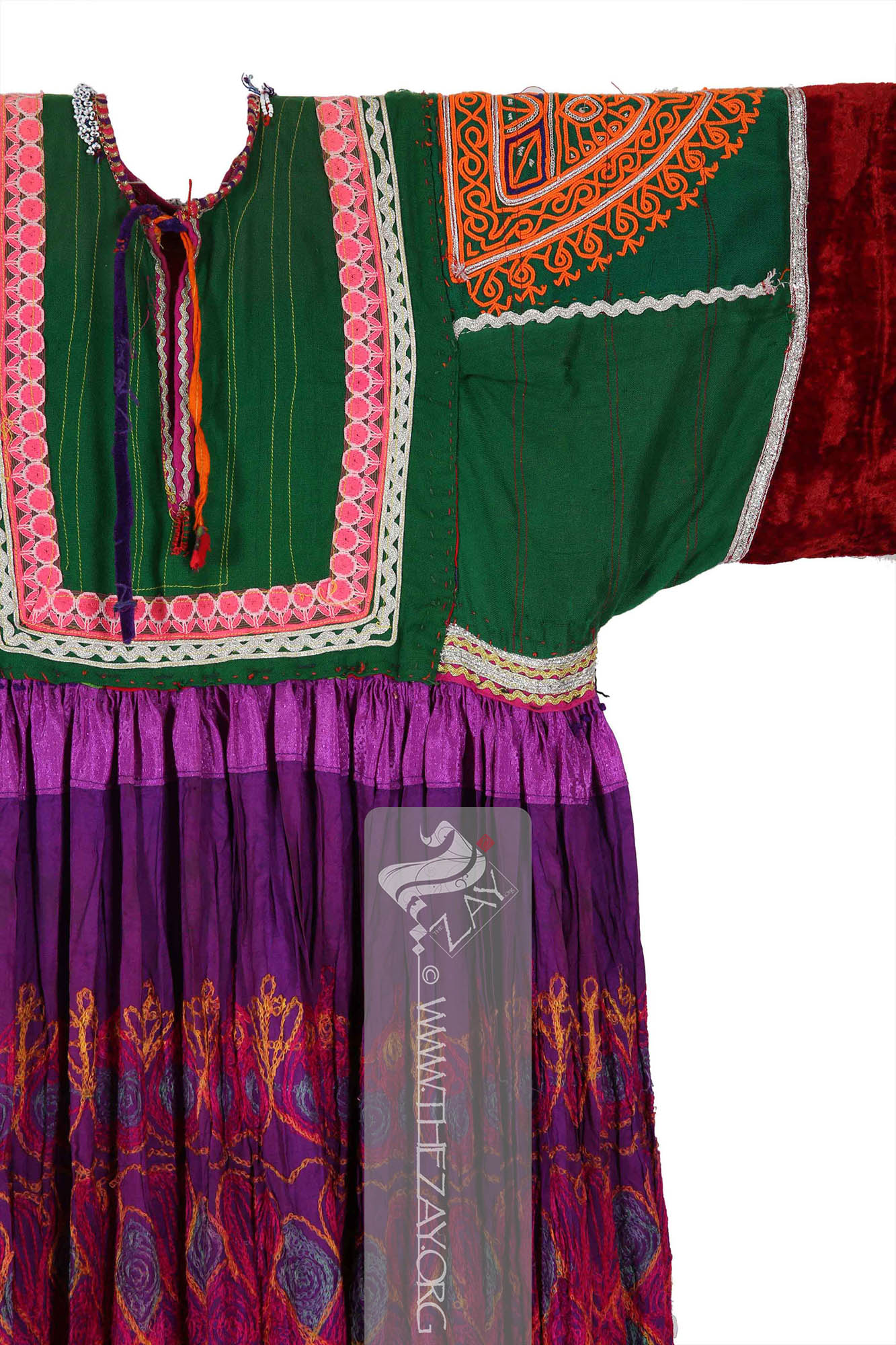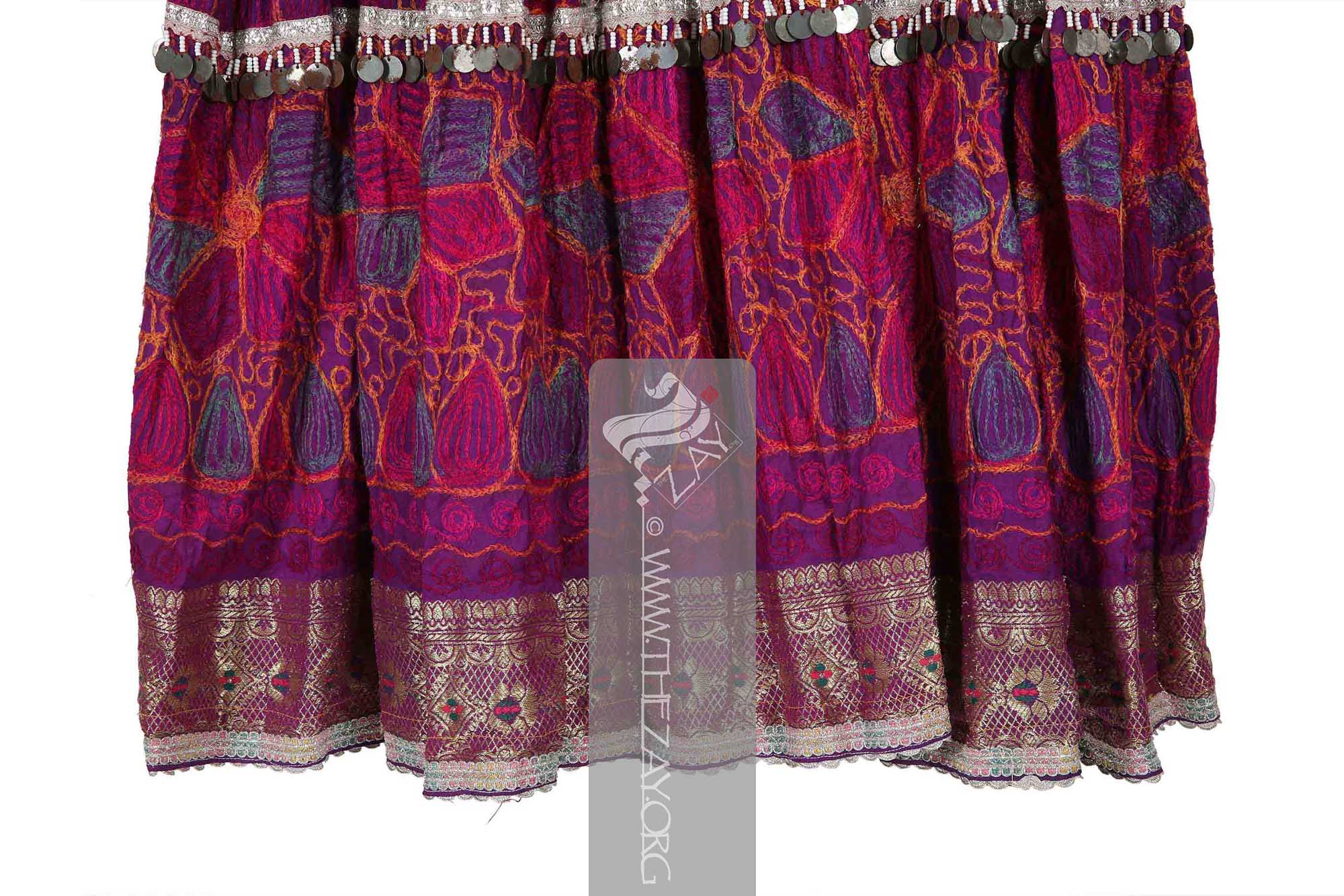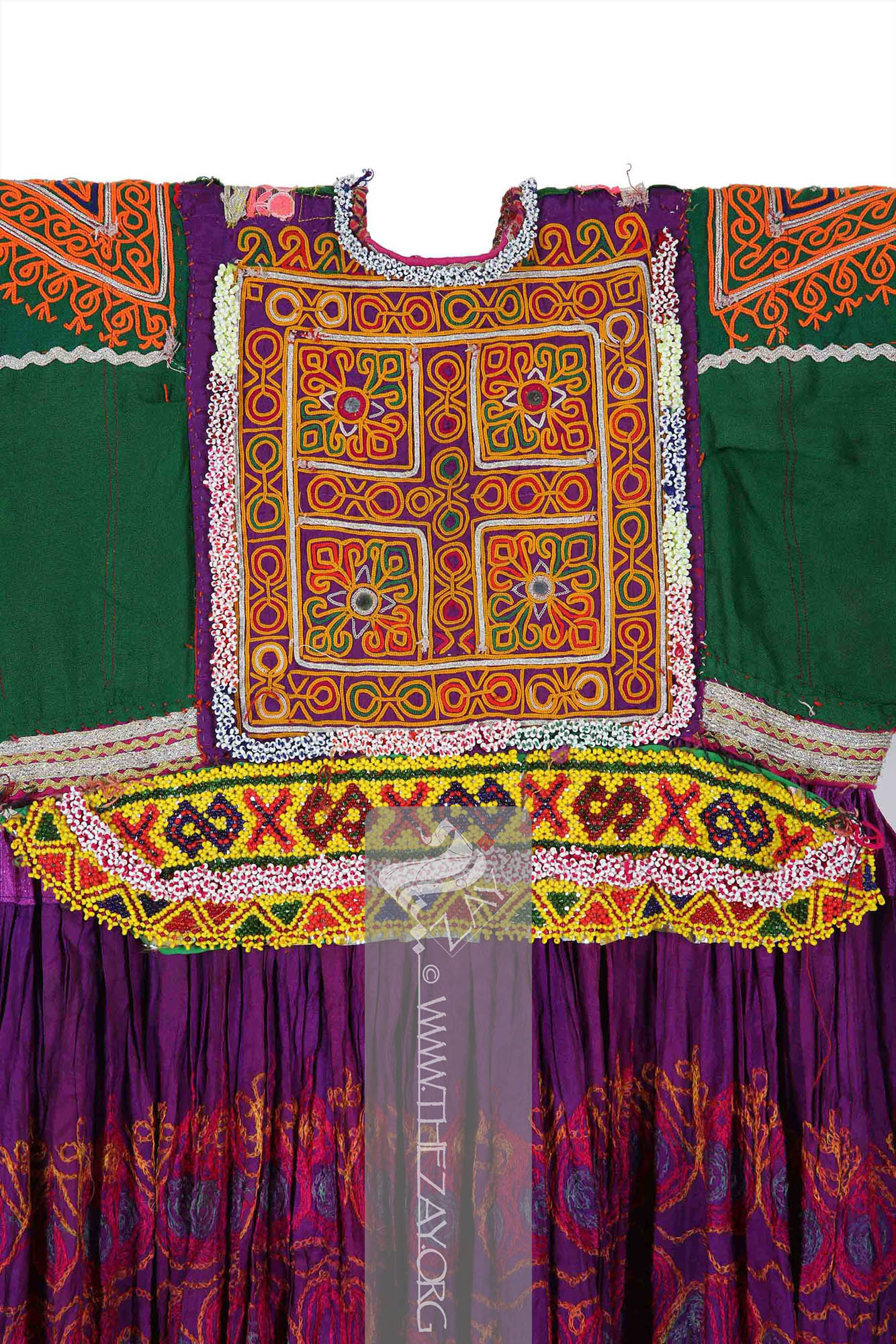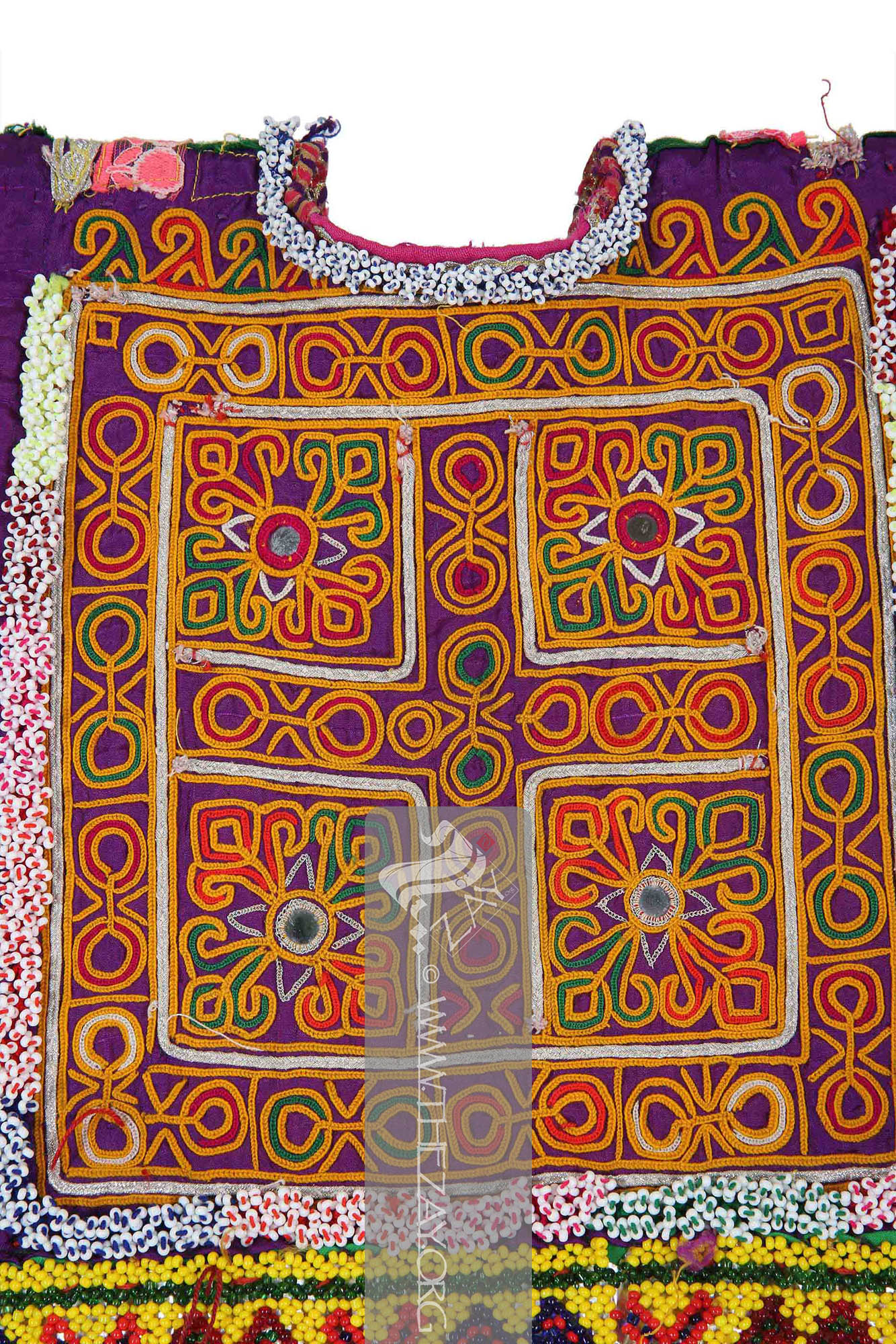Object HistoryThis colourful woman’s tunic belonging to the Kochi tribes native to Afghanistan and Balochistan province in Pakistan was purchased by
Dr. Reem Tariq
Ṭariq: (Arabic; Synonym: tulle_bi_talli
Tūlle_bi_tallī: (French: Tulle – a city in France where fine material for veil was first made; Turkish: tel – wire; Synonym: tariq; talli; badla; khus_dozi ), series of small metal knots made on a woven net ground as embellishment. The term is commonly used in the North African Arab region specifically in Egypt.
; talli; badla; khus_dozi ), series of small metal knots made on a woven net ground as embellishment. The term is commonly used in the Levant Arab region specifically in Lebanon.
El Mutwalli
Dr. Reem Tariq
Ṭariq: (Arabic; Synonym: tulle_bi_talli
Tūlle_bi_tallī: (French: Tulle – a city in France where fine material for veil was first made; Turkish: tel – wire; Synonym: tariq; talli; badla; khus_dozi ), series of small metal knots made on a woven net ground as embellishment. The term is commonly used in the North African Arab region specifically in Egypt.
; talli; badla; khus_dozi ), series of small metal knots made on a woven net ground as embellishment. The term is commonly used in the Levant Arab region specifically in Lebanon.
el Mutwallī: Founder (CEO) of the Zay
Zay: (Arabic: costume, Pl. azyaā’), a set of clothes in a style typical of a particular country or historical period. Initiative, a public figure, speaker and author. An expert curator and consultant in Islamic art and architecture, interior design, historic costume, and UAE heritage. at the Sharjah Islamic Market (suq), recently named The Blue Souk, UAE in 1998. It was eventually added to The
Zay
Zay: (Arabic: costume, Pl. azyaā’), a set of clothes in a style typical of a particular country or historical period. Initiative.
Object Features This is a typical woman’s dress from the Kochi nomadic tribes – also colloquially Kacchi – primarily from Afghanistan and native to parts of Pakistan and Iran. It has a green woollen
bodice
Bodice: (English: body), or bodices the plural form of body, it is the close-fitting garment meant to cover the body above the waist or the torso. However, it was not until the 17th century that the term became synonymous to women’s undergarment. with a purple silk skirt and velvet sleeves.
The (
bodice_yoke
Bodice_Yoke: (Synonym: Yoke
Yoke: (Synonym: Bodice_Yoke), a structured pattern fitted at the shoulders defining the structure of women’s garments. Introduced in c. 1880s it defines the transition between the upper and lower parts of the garments and can now be found stitched-in where the blouse is separated from the skirt by a horizontal seam. ), a structured pattern fitted at the shoulders defining the structure of women’s garments. Introduced in c. 1880s it defines the transition between the upper and lower parts of the garments and can now be found stitched-in where the blouse is separated from the skirt by a horizontal seam. )/(
yoke
Yoke: (Synonym: Bodice_Yoke), a structured pattern fitted at the shoulders defining the structure of women’s garments. Introduced in c. 1880s it defines the transition between the upper and lower parts of the garments and can now be found stitched-in where the blouse is separated from the skirt by a horizontal seam. ) of the dress is constructed of a green wool woven fabric attached to a full skirt with pleating at the waist in two different fabrics. The top fabric is a narrow panel of purple silk (
damask
Dāmāsk: (Arabic: Damascus – a city in Syria), is a luxurious fabric woven with reversible patterns typically in silk, wool, linen, or cotton. Originating in China, the fabric was perhaps introduced to European traders at Damascus – a major trading post on the Silk Road with a thriving local silk industry. ) with small diamond-shaped motifs while the bottom is made of plain purple field with a dense
brocade
Brocade: (Italian: brocco – twisted thread), is a richly decorative fabric woven with an intricate raised pattern. Its origins can be traced back to ancient China, where it was made for the imperial court. It later spread to Europe during the Renaissance and became popular in couture and decorative arts. border.
The plain purple field is mostly covered with (
chain_stitch
Chain_stitch: An embroidery technique where a looped stitch is made in a continuous chain-like pattern. Each stitch is formed by looping the thread through the previous stitch, creating a linked chain. ) embroidery depicting geometric and floral motifs in orange, blue, and pink silk
floss
Floss: (Old French: flosche – nap of velvet), is a type of silk fibre obtained from the cocoons of wild silkworms. It is characterized by its long, fluffy fibers that are not tightly woven, making it ideal for use in various textile applications such as embroidery, lace-making, and sewing. threads. The middle of the skirt has a ribbon trimming.
The ribbon is constructed of metal foil threads – silver-coloured metallic threads wrapped in cotton, along with silver colour plastic foil with beads and small metal discs.
The hem of the skirt has a thick
brocade
Brocade: (Italian: brocco – twisted thread), is a richly decorative fabric woven with an intricate raised pattern. Its origins can be traced back to ancient China, where it was made for the imperial court. It later spread to Europe during the Renaissance and became popular in couture and decorative arts. border with intricate floral and geometric motifs woven in golden metallic, green and pink cotton threads. The hem also has an additional layer of embellishment in the form of an edging ribbon constructed of metal foil and pale pink, green and yellow cotton threads. The skirt of the tunic is not lined except for the edging ribbon with plain red cotton fabric.
The sleeves are constructed of three different fabrics. A (
crimson
Crimson: (Persian/Arabic and Turkish: qirmiz or kirmiz – red), is a vivid red color originally made from the dried bodies of a scale insect of the Kermes genus native to the Mediterranean region and was used as a dye for clothing and textiles.) red velvet covers the upper arms which are followed by a purple velvet covering the elbows and the forearms and a thick patch of pink wool with (
suzani
Suzani: (Farsi: suzandozi : needlework, from Farsi: suzan: needle, dozi: embellishment), type of embroidered and decorative Central Asian tribal textile art usually on a cotton fabric, embroidered in both silk or cotton thread with primarily chain, satin, and buttonhole stitches as well as couching technique. ) style embroidery in yellow, blue, green and red for the cuffs. The edge of both sleeves is trimmed with blue plastic beads. The three parts of the sleeves are distinguished with plastic silver foil trimmings much like the skirt but thinner.
The
yoke
Yoke: (Synonym: Bodice_Yoke), a structured pattern fitted at the shoulders defining the structure of women’s garments. Introduced in c. 1880s it defines the transition between the upper and lower parts of the garments and can now be found stitched-in where the blouse is separated from the skirt by a horizontal seam. is primarily made of a thin green woollen base. The front of the
yoke
Yoke: (Synonym: Bodice_Yoke), a structured pattern fitted at the shoulders defining the structure of women’s garments. Introduced in c. 1880s it defines the transition between the upper and lower parts of the garments and can now be found stitched-in where the blouse is separated from the skirt by a horizontal seam. has a round neck and a slit down the middle as an opening with cotton and elastic velvet bands as fasteners which are stitched on either side of the opening.
The sides of the front opening are trimmed with yet another thin zigzag metal foil ribbon with pink and ivory lace trimming around the
yoke
Yoke: (Synonym: Bodice_Yoke), a structured pattern fitted at the shoulders defining the structure of women’s garments. Introduced in c. 1880s it defines the transition between the upper and lower parts of the garments and can now be found stitched-in where the blouse is separated from the skirt by a horizontal seam. with a broader zigzag metal foil ribbon. It has
suzani
Suzani: (Farsi: suzandozi : needlework, from Farsi: suzan: needle, dozi: embellishment), type of embroidered and decorative Central Asian tribal textile art usually on a cotton fabric, embroidered in both silk or cotton thread with primarily chain, satin, and buttonhole stitches as well as couching technique. embroidery spilling on both sides of the shoulders in orange-blue and metal foil threads.
The back of the
yoke
Yoke: (Synonym: Bodice_Yoke), a structured pattern fitted at the shoulders defining the structure of women’s garments. Introduced in c. 1880s it defines the transition between the upper and lower parts of the garments and can now be found stitched-in where the blouse is separated from the skirt by a horizontal seam. has a rectangular patch in purple silk with mirror works and
suzani
Suzani: (Farsi: suzandozi : needlework, from Farsi: suzan: needle, dozi: embellishment), type of embroidered and decorative Central Asian tribal textile art usually on a cotton fabric, embroidered in both silk or cotton thread with primarily chain, satin, and buttonhole stitches as well as couching technique. embroidery in green, yellow, purple, and red threads as embellishments. This patch is bordered with a trimming of tiny plastic white beads in multi-coloured threads. Four metal foil corded ribbons – two in silver and two golden – are sewn along the waistline covering just the sides in an alternate sequence.
The back waistline is covered with an oval-shaped fabric embroidered with multi-coloured beads depicting geometric shapes or (
gul_i_peron
Gul_i_peron: (Farsi and Urdu: Gul – Flower; or Turkish: Rose; Farsi and Urdu: Pairahan – Garment or Shirt), a fabric embellishment craft of ancient Persian origin involving heavy beadwork often featuring floral motifs and a mirror centrepiece to deflect evil eye from the wearer. It is still famous in South and Central Asia. ). This patch of fabric was made separately and attached to the garment and was completely handmade with plastic foils from chips and other packaged edibles as a layer between the beads and the fabric.
The lining of the piece which is primarily limited to the
yoke
Yoke: (Synonym: Bodice_Yoke), a structured pattern fitted at the shoulders defining the structure of women’s garments. Introduced in c. 1880s it defines the transition between the upper and lower parts of the garments and can now be found stitched-in where the blouse is separated from the skirt by a horizontal seam. and the sleeves is constructed of three primary fabrics – a floral printed red cotton, a brown possibly thin wool printed with green, yellow and pink floral motifs and dots and a
coral
Coral: (Greek: korallion, probably from Hebrew: goral – small pebbles), is a pale to medium shade of pink with orange or peach undertones, resembling the colour of certain species of coral. plain cotton.
Interestingly, most of these dresses that are found in the West today are samples from c. 1970s Afghanistan. Although traditional women’s dresses of nomadic pastoral tribes, the flamboyancy of these dresses became synonymous with Afghanistan thus identifying the country to the West, especially during the hippie era.
Links
- Valérie Bérinstain, Mary Hunt Kahlenberg, Zaira Mis, Marcel Mis. Asian Costumes and Textiles from the Bosphorus to Fujiyama: The Zaira and Marcel Mis Collection. California: Skira, 2001.
- Suleman, Fahmida. Textiles of the Middle East and Central Asia (British Museum) The Fabric of Life. London: Thames and Hudson, 2017.
- Embroidery from Afghanistan Fabric, folios. Sheila Paine. Washington: University of Washington Press, 2006.
- Sukhareva, Olʹga Aleksandrovna. Suzani
Suzani: (Farsi: suzandozi : needlework, from Farsi: suzan: needle, dozi: embellishment), type of embroidered and decorative Central Asian tribal textile art usually on a cotton fabric, embroidered in both silk or cotton thread with primarily chain, satin, and buttonhole stitches as well as couching technique. : Central Asian Decorative Embroidery. Samarkand: SMI Asia, 2013.
- https://referenceworks.brillonline.com/entries/encyclopaedia-iranica-online/clothing-COM_7759?lang=fr#COM-10186
- https://trcleiden.nl/trc-digital-exhibition/index.php/dressing-the-stans/item/109-decorative-needlework
- https://trc-leiden.nl/trc-digital-exhibition/index.php/afghan-dress/item/72-hamid-karzai-and-afghan-unification
- https://trc-leiden.nl/trc-digital-exhibition/index.php/afghan-dress/item/74-baluchi-dress
- https://www.wearableheritage.com/gul-i-peron
- https://www.ancientbeadwork.com/gul-i-peron








